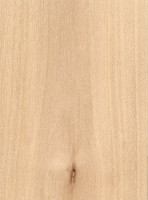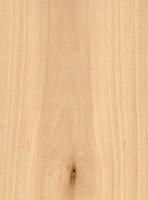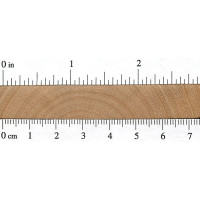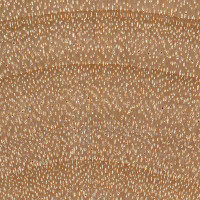 |
Common Name(s): Sweet Birch Scientific Name: Betula lenta Distribution: Northeastern North America Tree Size: 65-100 ft (20-30 m) tall, 2-3 ft (.6-1.0 m) trunk diameter Average Dried Weight: 46 lbs/ft3 (735 kg/m3) Specific Gravity (Basic, 12% MC): .60, .74 Janka Hardness: 1,470 lbf (6,540 N) Modulus of Rupture: 16,900 lbf/in2 (116.6 MPa) Elastic Modulus: 2,170,000 lbf/in2 (14.97 GPa) Crushing Strength: 8,540 lbf/in2 (58.9 MPa) Shrinkage: Radial: 6.5%, Tangential: 9.0%, Volumetric: 15.6%, T/R Ratio: 1.4 |
Color/Appearance: Heartwood tends to be a light reddish brown, with nearly white sapwood. Occasionally figured pieces are available with a wide, shallow curl similar to the curl found in Cherry. There is virtually no color distinction between annual growth rings, giving Birch a somewhat dull, uniform appearance.
Grain/Texture: Grain is generally straight or slightly wavy, with a fine, even texture. Low natural luster.
Endgrain: Diffuse-porous; primarily radial multiples; medium pores in no specific arrangement, moderately numerous to numerous; parenchyma marginal, and sometimes diffuse-in-aggregates (faintly visible with lens); narrow rays, spacing fairly close to close.
Rot Resistance: Birch is perishable, and will readily rot and decay if exposed to the elements. The wood is also susceptible to insect attack.
Workability: Generally easy to work with hand and machine tools, though boards with wild grain can cause grain tearout during machining operations. Turns, glues, and finishes well.
Odor: No characteristic odor.
Allergies/Toxicity: Birch in the Betula genus has been reported as a sensitizer. Usually most common reactions simply include skin and respiratory irritation. See the articles Wood Allergies and Toxicity and Wood Dust Safety for more information.
Pricing/Availability: Likely to be rather economical in most instances. Figured boards can be more expensive, but normally plain birch lumber is in the same price range as maple or oak.
Sustainability: This wood species is not listed in the CITES Appendices or on the IUCN Red List of Threatened Species.
Common Uses: Plywood, boxes, crates, turned objects, interior trim, and other small specialty wood items.
Comments: Birch is one of the most widely used woods for veneer and plywood worldwide. Besides regular sheets of plywood, Birch veneer is also used for doors, furniture, and paneling.





Is there any reliable objective way to differentiate yellow and sweet birch? Both are common in my area (NH) but after a week of analyzing samples from around my property I still can’t find a consistent distinction: bark color and bud/twig color all vary too much from individual to individual. Even on the endgrain the only difference I can find is that sweet birch has a growth rate more like hard maple or hophornbeam whereas yellow birch has wider growth rings much like paper birch. Any thoughts?
They say these two two trees are perhaps best differentiated by the flavor of their green twigs. Yellow birch will smell of wintergreen but with a bitter, somewhat astringent taste. Sweet birch, as the name implies will have a sweeter and more potent scent, with a deliciously sweet wintergreen flavor. The bark of yellow birch will have small curls of material similar to paper birch but thinner, with a golden hue. Sweet birch, in juvenille specimens, will be relatively smooth with the all familiar lenticles all birch trees have. Sweet birch, in mature specimens will have large cracks and thick… Read more »
This wood contains salicylate, hence the wintergreen aroma and anti-prostaglandin physiological properties (like aspirin). It may also have been used in “birch beer” or “root beer.”